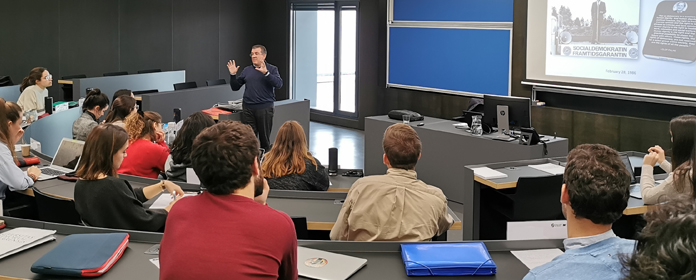Market Access, "a critical and highly demanded function".
The director of NBD and Government Affairs Janssen, Antonio Fernández, gives a lecture within the Master's Degree in management of Pharma-Biotech Companies.

Market Access functions within the pharmaceutical industry are goal to assist companies in negotiating pricing and reimbursement conditions for new pharmaceutical products. These functions have become more relevant as public health systems need to balance access to innovation with budgetary constraints. To this end, it is essential to assess the value provided by these drugs at both the clinical and economic levels.
Antonio Fernández, director of NBD and Government Affairs Janssen, gave a talk on Market Access at Campus in Madrid at the University of Navarra, where he met with students of Master's Degree in management of Pharma-Biotech Companies and alumni of the School of Pharmacy and Nutrition.
In the course, he explained and reflected on the challenge posed by the introduction of new drugs in the Health System. Why is the figure of Market Access relevant?
assessment Currently, the adoption of new technologies in healthcare subject - as is the case with drugs - and especially in healthcare systems where public funding is provided, requires a prior assessment of the value they provide, taking into account not only their usefulness and clinical benefit, but also economic aspects such as acquisition cost or budget affordability. This assessment is a requirement that public funding authorities systematically add to regulatory approval and makes the Market Access function particularly relevant for companies and for patients themselves.
In what way?
From a healthcare perspective, if the value they represent is not demonstrated and understood, patients will not have access to these new options. From a purely business perspective, we could resort to the aphorism "no access, no business". This makes Market Access today a critical and highly demanded function.
What are the main functions of Market Access within laboratory pharma?
Market Access functions include substantiating, demonstrating and communicating the value of new medicines so that those that are of value to patients and the system can be made available. The substantiation and demonstration of value requires methodologies that belong to the field of Clinical research , Health Economics or the advanced analysis of big data (Big Data) in real world evidence (RWE) contexts, to give some examples. The communication and dissemination of value requires the prior creation of what we colloquially call "value stories" which are, in our view, fundamental in price and reimbursement claims and in interactions with decision makers.
How has this function evolved over the last fifteen years?
From a technical point of view, the function has been enriched by the adoption of new methodologies, such as the analysis of macro data in real clinical internship situations, which have improved the classic economic analyses and the research of health outcomes -Outcomes research-. Another aspect that has changed a lot is everything that has to do with the design of "Access Schemes", which are the mechanisms and solutions that make it possible to incorporate innovation, allowing the system to be sustainable and innovation to be affordable. But I would say that the most important change B is the increase in evaluation and demand for Market Access professionals.
What criteria does manager Market Access take into account when preparing a price negotiation for an innovative product?
We use three criteria core topic: the first is the additional clinical benefit from the patient's perspective, the second is that the new option represents "value for money" for the system at the requested price and the third is that it is affordable for the funder/payer.
What are the most relevant variables when preparing a pricing dossier for an innovative product?
In addition to fill in the required formal aspects, it is important that the three criteria to which I referred earlier: clinical benefit, cost-effectiveness and budgetary impact are made clear.
Young professionals face a constantly changing labor market, both in terms of the skills and competencies required and in terms of technical and specialized knowledge. Market Access is also the result of this adaptation and change in the health sector. What do you consider essential for a professional who wants to develop in Market Access?
Curiosity, interest and critical thinking, in addition to being willing to make the effort required to be educated and trained in the knowledge that the function requires. financial aid much have a solid scientific base with good training in health sciences -including pharmacology, methodology of clinical research and statistics-, which allows him/her to identify the value drivers of new drugs based on a good understanding of the disease or disorder we are talking about, the management of this and the place that the new option occupies in therapeutics.
What are the most in-demand skills?
We are looking for people with a capacity for learning and continuous study. Analytical skills, to compare based on different interpretations of data and results, to be able to make a critical reading of the scientific literature and draw their own conclusions. Narrative skills, to be a good creator of "value stories", making the apparently complex understandable to the audiences we work with and communication skills, to have the ability to communicate effectively.
